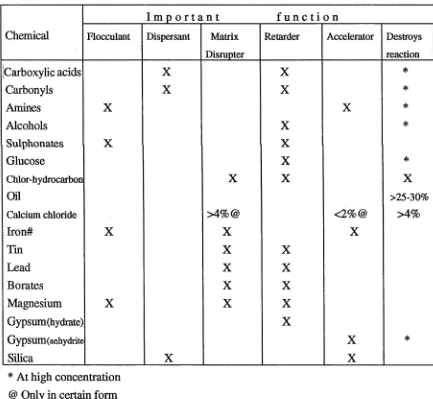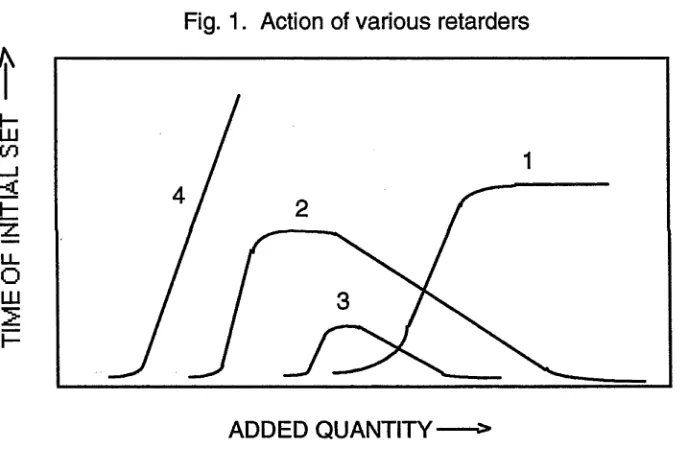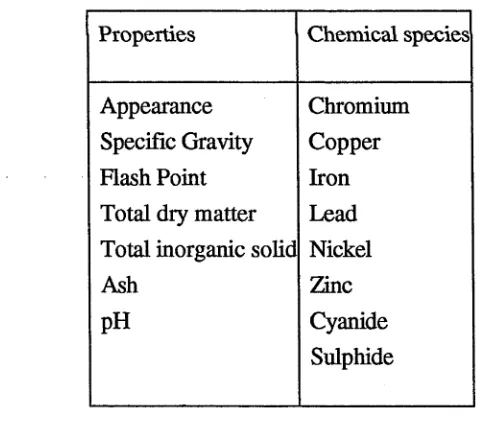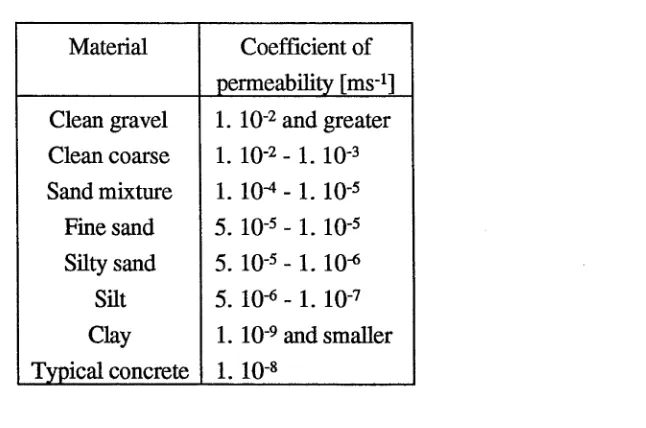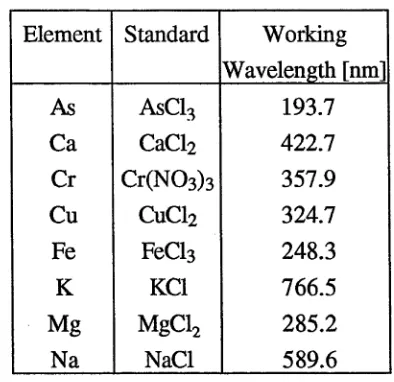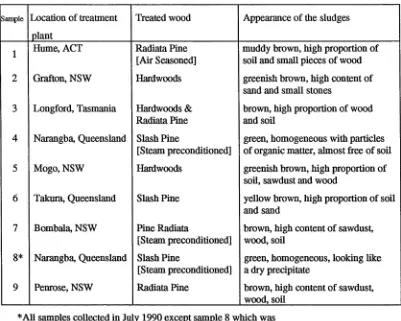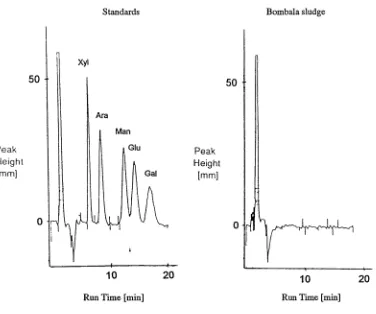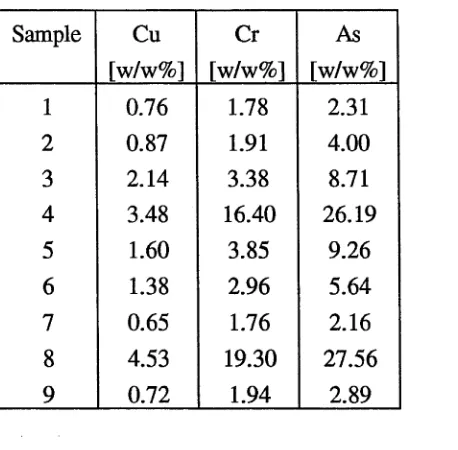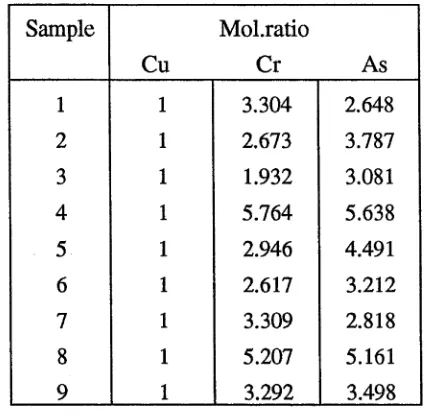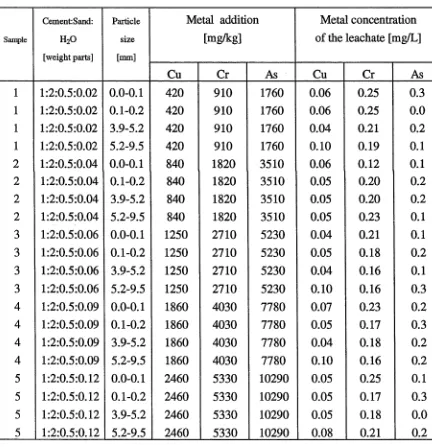(CCA) sludge from timber treatment plants
by
Milan Melicher
A thesis submitted for the degree of Master of Science
at The Australian National University
Except where indicated otherwise this thesis is my own work
-fia— D
manufactured in the laboratory were treated using cement-based stabilisation/solidifica tion (s/s) process. The stability o f these sludges solidified within cement-sand matrices was tested using the standard regulatory method for assessing the leachability o f solid waste prior to its disposal by landfill, the Toxicity Characteristic Leaching Procedure (TCLP test). During the test the samples were leached using an acetic solution for 18 hours. The regulatory acceptable concentrations o f Cu, Cr and As in the leachate according to the Environmental Protection Authority (EPA) standards are 5 mg/L, 5 mg/L and 100 mg/L respectively. Although there is no regulatory requirements for structural strength o f solid waste prior to its disposal in Australia, the effect o f metal addition on unconfined compressive strength o f cement-sand matrices was examined.
Cement-sand matrices which contained sludge manufactured in the laboratory or from the Narangba treatment plant showed little loss o f metals after leaching. All o f the s/s samples containing As in the concentration range 1800 to 41200 mg/kg, (chromium and copper were in the range o f 910 to 25800 mg/kg and 390 to 5500 mg/kg respectively) had a concentration o f As in the leachate o f below 1 mg/L. The Narangba sludge and synthetic sludge were atypical sludges, since they were practically free o f soluble CCA compounds. The major components o f these sludges were chromium and copper arsenates which are sparingly soluble in water. When stabilised by cement they are stable in the TCLP acetic solutions and may not be considered hazardous to the environment.
It was found that the leaching o f metals from cement-sand matrices was dependent on the concentration o f water-soluble chromium and arsenic present in the sludges. The sludges from commercial treatment plants contained water-soluble arsenic and chromium in the range o f 47 - 904 mg/kg and 35 - 1294 mg/kg respectively. In order to reduce the concentration o f water-soluble metals and convert them into insoluble chromium and copper arsenates, some o f the sludges were pretreated by the addition o f sawdust as a reducing agent. The addition o f 10 % hardwood sawdust to sludge from the M ogo treatment plant reduced the concentration o f water-soluble arsenic 7-fold and chromium 117-fold. The s/s treated sludges from the Mogo treatment plant without the addition o f sawdust did not pass the TCLP test. However, all o f the sludges which were pretreated by sawdust met the EPA standards for disposal by landfill. Although the loadings o f As and Cr in the s/s processed waste were up to 60130 mg/kg and 25000 mg/kg respectively, the concentration o f As and Cr in the leachates was under 5 mg/L.
Copper concentration in the leachates was 3000 times less than the theoretical leaching based on the addition o f copper sulphate to cement-sand mixes. Chemical stabilisation rather then physical encapsulation was probably responsible for this reduction o f copper mobility. Water-soluble copper might be stabilised by adsorption on cement or by the formation o f copper hydroxide. The concentration o f Cu in the most stabilised sludges was less than 1 mg/L. Cu in the form o f C u S 0 4.5H20 significantly retards the hydration o f cement and reduces the unconfined compressive strength o f cement-sand matrices.
Arsenic trioxide (III) and As20 5 were stabilised by cement-sand mixes consisting o f 1 part o f cement and 2 parts o f sand. These mixes released only around 1% o f As present in the s/s form and the concentration o f arsenic in all o f the leachates was less than 1 mg/L. Arsenic(V) in the form o f As20 5 in pure cement inhibited hydration. The contaminated cement-sand mix hardened after two days o f curing, but had substantially reduced unconfined compressive strength. The unconfined compressive strength of cement-sand matrices containing 2 parts o f As(V) in the form o f As20 5 per 100 parts of cement and 200 parts o f sand was 60 N/cm2. Although As(III) affected the morphology o f cement, the unconfined compressive strength o f As(III)-bearing cement-sand matrix was relatively high (990 N/cm2).
Acknowledgments
This research work was conducted at the Department of Forestry of The Australian
National University supported by the National Teaching Company Scheme (Department
of Industry, Technology and Commerce, DITAC) and Koppers Australia. I would like
to express my gratitude to DITAC and Koppers and to:
Dr. Philip D. Evans of Department of Forestry, The Australian National University for
his guidance and support in directing the research and thesis preparation;
Mr. Keith Riley of Koppers Australia for his encouragement and advice during the
research work;
Dr. Ann Gibson and Dr. Robin Wingate-Hill of Department of Forestry, The Australian
National University for their comments and suggestions in structuring and editing the
thesis;
Dr. Ging Khoe and Dr. Josick Comarmond of Environmental Science Program, the
Australian Nuclear Science and Technology Organisation for their comments and advice
during the writing of the thesis;
Mr. Roger Heady of Research School of Biological Sciences, The Australian National
Table of contents
Page No.
Abstract
Acknowledgments
List of Figures
List of Micrographs
List of Tables
List of Appendices
iii
vi
vii
viii
x
1. Introduction
1
1.1. Objective and scope
1
1.2. Study outline
3
2. Literature review
4
2.1. CCA formulation and fixation reactions in timber
4
2.2. CCA sludge formation
8
2.2.1. Effect of process conditions at treatment plants on sludging
10
2.3. Cement-based stabilisation/solidification (s/s) techniques
10
and leach testing procedures
2.3.1. Operational procedures
11
2.3.2. Binders
11
2.3.2.1. Portland cement
12
2 3 .2.2.
Lime/flyash
12
2.3.3. Characterisation of stabilised wastes
13
2.3.4. Assessment of product quality
16
2.3.4.1. Surface techniques
16
2.3.4.2. Leach and physical testing procedures
17
2.4.
Concluding summary
20
3. Characterisation of CCA sludges
21
3.1.
Materials and methods
21
3.1.1. Preparation of synthetic CCA sludge
21
3.1.2. Characterisation of sludges from timber treatment plants
22
3.1.2.1. Air-dry sludge
22
3.1.2.2. Oven-dry sludge
22
3.1.2.3. Organic matter lost on ignition
22
3.1.2.4. pH determination of sludges
23
3.1.2.5. Determination of metals
23
3.1.2.6. Determination soluble copper, chromium and arsenic in the sludges
24
3.1.2.7. Determination of chlorides, sulphides and sulphates
24
3.1.2.8. Determination of mono and disaccharides
25
4. Stabilisation/solidification of synthetic or relatively pure CCA sludges
37
4.1. Materials and methods
37
4.1.1. CCA sludge from CSR-Permalog Narangba plant
37
4.1.2. Preparation of solidified samples
37
4.1.3. Preparation of Cr(III), Cr(VI), Cu(II), As(III), and As(V)-bearing cement- 39
sand mixes
4.1.4. Leaching tests of solidified wastes
39
4.1.5. Unconfined compressive strength measurement
39
4.2. Results
40
4.2.1. Leaching results
40
4.2.2. Compressive strength results
48
4.2.3. SEM results
51
5. Stabilisation/solidification of sludges from commercial treatment plants
57
5.1. Materials and method
57
5.2. Results
57
6. General discussion
66
6.1. Effect of sawdust treatment on the leaching of Cr and As from s/s wastes 66
6.2. Stabilisation of chromium in s/s forms
67
6.2.1. Effect of Cr(VI)
67
6.2.2. Effect of Cr(in)
77
6.3. Stabilisation of copper in s/s forms
78
6.4. Stabilisation of arsenic in s/s forms
79
7. Conclusions and Recommendations
82
8. References
84
List of Figures
Page No.
Fig. 1. Action of various retarders
14
Fig. 2. HPLC traces for external standards and the leachate from Bombala sludge 29
Fig. 3. Concentration of water-soluble Cu, Cr and As in the Mogo sludge after
35
the addition of 10% and 20% of sawdust
Fig. 4. Concentration of water-soluble Cu, Cr and As in the Penrose sludge after 35
the addition of 10% and 20% of sawdust
Fig. 5. Cu, Cr and As concentration in the leachates of samples with addition
43
of Narangba sludge
Fig. 6. Cr concentration in the leachate of samples with addition of C r03
45
Fig. 7. Cr concentration in the leachate of samples with addition of Cr20 3
45
Fig. 8. Cu concentration in the leachate of samples with addition of CuS04.5H20 46
Fig. 9. As concentration in the leachate of samples with addition of As20 3
47
Fig. 10. As concentration in the leachate of samples with addition of As20 5
47
Fig. 11. Compressive strength of cement-sand samples with addition
49
of 0.4 and 0.5 parts of water per 1 part of cement
Fig. 12. Compressive strength of cement-sand samples containing Narangba
50
sludge
Fig. 13. Cu, Cr and As concentrations in the leachate from s/s Penrose sludge
64
Fig. 14. Cu, Cr and As concentrations in the leachate from s/s Mogo sludge
64
Fig. 15. Cu, Cr and As concentrations in the leachate from s/s Bombala sludge
64
Fig. 16. Cu, Cr and As concentrations in the leachate from s/s Hume sludge
64
Fig. 17. Cr concentration in the leachate from s/s Penrose sludge with addition
65
of sawdust
Fig. 18. As concentration in the leachate from s/s Penrose sludge with addition
65
of sawdust
Fig. 19. Cr concentration in the leachate from s/s Mogo sludge with addition
65
of sawdust
List of Micrographs Page No.
Micrograph 1. Portland cement after 7 days of hydration 54
Micrograph 2. Portland cement after 7 days of hydration 54
Micrograph 3. Portland cement with 1% additional Cr(III) (Cr20 3) after 7 days 54 of hydration
Micrograph 4. Portland cement with 1% additional Cr(III) (Cr20 3) after 7 days 54 of hydration
Micrograph 5. Portland cement with 1% additional Cr(VI) (C r0 3) after 7 days 55 of hydration
Micrograph 6. Portland cement with 1% additional Cr(VI) (C r0 3) after 7 days 55 of hydration
Micrograph 7. Portland cement with 1% additional Cu(II) (C uS04.5H20 ) 55
after 7 days of hydration
Micrograph 8. Portland cement with 1% additional Cu(II) (C uS04.5H20 ) 55
after 7 days of hydration
Micrograph 9. Portland cement with 1% additional As(ffl) (As20 3) after 7 days 56 of hydration
Micrograph 10. Portland cement with 1% additional As(III) (As20 3) after 7 days 56 of hydration
Micrograph 11. Portland cement with 1% additional As(V) (As20 5) after 7 days 56 of hydration
List of Tables Page No.
Table 1. Effect of selected chemicals on cement-based pozzolanic processes 13
Table 2. Typical assessment analysis for a waste accepted for a cement 15
based-solidification process
Table 3. Compressive strengths of wastes treated by Sealosafe formulations 18
Table 4. Permeability coefficient of materials 19
Table 5. Acceptance criteria for landfill disposal 19
Table 6. Standards and working conditions for Atomic Absorption Spectroscopy 24
Table 7. Concentration of Cu, Cr and As in the synthetic sludge 26
Table 8. Location of Koppers treatment plants from which the sludges were 27
obtained and the type of wood treated at the plant
Table 9. Moisture content (WP) and lost on ignition (LI) of the sludges from 28 Koppers treatment plants
Table 10. pH of the sludges from Koppers treatment plants 30
Table 11. Concentrations of copper, chromium and arsenic in the sludges 31
from Koppers treatment plants
Table 12. Cu : Cr : As molar ratio in the sludges from Koppers treatment plants 32 Table 13. Concentrations of Cr(VI) in the sludges from Koppers treatment plants 32 Table 14. Concentrations of iron, alkali metals and alkaline earths in the sludges 32
from Koppers treatment plants
Table 15. Concentrations of chlorine and sulphur in the sludges from Koppers 34 treatment plants
Table 16. Composition of Kandos Portland cement 38
Table 17. Leachability of Cu, Cr and As from cement-sand samples containing 40
synthetic CCA sludge
Table 18. Leachability of Cu, Cr and As from cement-sand samples containing 41
synthetic CCA sludge: Effect of particles sizes
Table 19. Leachability of Cu, Cr and As from cement-sand samples containing 42
Narangba sludge
Table 20. Leachability of Cu, Cr and As from cement-sand samples containing 44
Narangba sludge and C r 0 3
Table 21. Compressive strength of cement-sand samples containing 100 parts 51
Table 22. Cu, Cr and As concentrations in the leachate from s/s Penrose sludge
58
without the addition of sawdust
Table 23. Cu, Cr and As concentrations in the leachate from s/s Mogo sludge
59
without the addition of sawdust
Table 24. Cu, Cr and As concentrations in the leachate from s/s Bombala sludge
60
without the addition of sawdust
Table 25. Cu, Cr and As concentrations in the leachate from s/s Hume sludge
61
without the addition of sawdust
Table 26. Cu, Cr and As concentrations in the leachate from s/s Penrose sludge
61
with the addition of 10% of hardwood sawdust
Table 27. Cu, Cr and As concentrations in the leachate from s/s Mogo sludge
62
with the addition of 10% of hardwood sawdust
Table 28. Solubility products for some Cu, Cu and As substances
68
Table 29. Predicted concentrations,
CFCr(vi)and determined concentrations,
72
MCr(vi)
of Cr in the leachates from s/s Bombala sludge
Table 30. Predicted concentrations,
CFCr(vi)and determined concentrations,
73
MCr(vi)
of Cr in the leachates from s/s Hume sludge
Table 31. Predicted concentrations,
CFCr(vi)and determined concentrations,
73
MCr(vi)
of Cr in the leachates from s/s Penrose sludge
Table 32. Predicted concentrations,
CFCr(vi)and determined concentrations,
74
MCr(vi) of Cr in the leachates from s/s Mogo sludge
Table 33. Predicted concentrations,
CFCr(vi)and determined concentrations,
MCr(vi>74
of Cr in the leachates from s/s Penrose sludge with the addition of sawdust
Table 34. Predicted concentrations,
CFCr(vi)and determined concentrations,
MCr(vi)75
Appendix A. Concentrations of soluble Cu, Cr and As in the CCA sludges from 90 B om bala, Hume, Penrose and Mogo plants after the addition of sawdust and water
Appendix B. Concentration of Cr in the leachates (TCLP) of cement samples 90
with the addition of Cr(VI)
Appendix C. Concentration of Cr in the leachates (TCLP) of cement samples 91
with the addition of Cr(III)
Appendix D. Concentration of Cu in the leachates (TCLP) of cement samples 91
with the addition of Cu(II)
Appendix E. Concentration of As in the leachates (TCLP) of cement samples 92
with the addition of As (HI)
Appendix F. Concentration of As in the leachates (TCLP) of cement samples 92
with the addition of As(V)
Appendix G. Compressive strength of the samples containing synthetic sludge; 93
the addition of water 0.4 parts per 1 part of cement
Appendix H. Compressive strength of the samples containing synthetic sludge; 93
the addition of water 0.5 parts per 1 part of cement
Appendix I. Compressive strength of samples containing Narangba sludge 94
Chapter 1. Introduction
Copper-chromium-arsenic (CCA) preservatives are among the most important types of
wood preservatives (Hartford, 1973; Pizzi et al., 1984) and although a few problems are
encountered in their industrial use they generally perform satisfactorily. One of the most
important industrial problems with CCA preservatives is the formation of sludges during
wood treatment operations. Sludge formation causes the following problems: delays
caused by maintenance; loss of useable preservatives; and accumulation of sludges in
work tanks (Pizzi et al., 1984).
Sludge formation decreases the efficiency and effectiveness of treatment plants as well
as reducing their economic performance. In order to minimise sludge formation it is
necessary to have an insight into the chemical interactions of CCA with wood during
treatment and to examine the chemical composition of sludges and the causes and
mechanisms of their formation. As sludge is a hazardous waste, there has been
increasing interest in minimising sludge formation in treatment plants as well as using
stabilisation/solidification techniques for its safe disposal.
1.1. Objective and scope
The major objective of this thesis was to examine the chemical composition of CCA
sludges and methods of stabilising them in cement to ensure that they meet current
guidelines for the safe disposal of toxic waste. CCA sludges are mostly composed of
chromium arsenates and copper arsenates. Other components of sludges from
commercial treatment plants are sawdust and soil particles. As the treatment processes,
wood species and CCA concentrations vary from plant to plant the concentrations of the
components of sludges may be different. Differences in the composition of sludges might
be important if toxic components are to be immobilised in an environmentally safe
Cement-based methods of stabilisation/solidification have been used for the disposal of
CCA sludges. Concrete matrices containing up to 11500 mg of As per kg and 16000 mg
of Cr per kg have shown limited leachability of these metals, but other sludges also
treated by similar solidification/stabilisation methods released up to 14 mg/L of As and
150 mg/L of Cr to the leachate (Conner, 1990). Generally, Conner's work did not clarify
the effect of the composition of sludge on metal mobility.
The acceptance criteria for waste disposal by landfill according to the Environmental
Protection Authority of NSW are the concentrations of heavy metals in the leachate of
the waste subjected to the Toxicity Characteristic Leaching (TCLP) test. The acceptable
concentration for As and Cr is 5 mg/L. These concentrations were derived from the
standard for drinking water, but are 100 times in excess of the metal concentration
regarded as safe for drinking water.
In this study the leachability of metals from cement-sand matrices was assessed with
regard to the composition of CCA sludge and the cement-sand mix. The environmental
stability of stabilised samples was assessed by leaching them in dilute acetic acid of pH
2.8 for 18h (the TCLP test) and then examining the concentration of metals in the
leachate. The effect of the addition of sludges on the mechanical strength of cement-
sand mixes was also investigated by measuring the compressive strength of samples. To
assess the effect of some components of sludge on chemical stability and mechanical
strength, cement-sand mixes containing pure As, Cr and Cu compounds were tested.
The changes in the microstructure of these samples and also the effect of adding As, Cr
and Cu on the hydration of cement were investigated by Scanning Electron Microscopy
(SEM).
Some sludges were quite difficult to stabilise directly; therefore they were sometimes
pretreated using sawdust. Sawdust acts as a reducing agent and its effect on sludges was
of insoluble chromium arsenates, soluble As compounds present in sludges, which may
have a detrimental effect on the environmental stability of concrete matrices, are also
reduced by the formation of these arsenates. The effect of the addition of sawdust on the
immobilisation of metals in cement-sand matrix was thus elucidated.
1.2. Study outline
The following section (Chapter 2) reviews the relevant literature on the mechanism of
CCA fixation in timber, formation of sludge, effect of treatment procedures on sludge
formation, solidification/stabilisation methods for the immobilisation of the components
of sludge and the test methods for characterisation of immobilised wastes prior to
disposal by landfill. As the character of sludges is paramount to the quality of treated
waste, Chapter 3 outlines the methods and results for the characterisation of sludges
from various commercial treatment plants. Chapter 4 examines the stabilisa
tion/solidification of chemically pure sludges. The TCLP test was the most important
method used to assess the environmental stability of cement-based forms. Also in the
Chapter 4, the effect of CCA sludge on the structure of cement-sand mixes was
investigated using compressive strength measurements and SEM. Chapter 5 examines
the stabilisation/solidification of sludges from commercial treatment plants. Finally,
Chapter 6 discusses the results of the study, the effect of pretreating sludge with
sawdust on the teachability of metals from cement-sand forms, and the effect of Cu, Cr
and As compounds on the stability of s/s sludge. Chapter 7 presents the conclusions of
the study and the recommendations for future development of CCA sludge treatment
Chapter 2. Literature review
2.1. CCA formulation and fixation reactions in timber
A number of CCA formulations have been developed to reduce preservative cost and
minimise preservative leachability from wood. They differ mainly in the compositions of
single constituents or their relative proportions. The chemistry of the interaction of CCA
preservatives and wood has been described by Pizzi (1981, 1982a, 1982b) and Dahlgren
(1972). The fixation of CCA solutions in timber is a complicated process involving
proton-consuming and proton-liberating reactions (Dahlgren, 1972). During treatment
CCA solutions are subjected to partial reduction by organic wood compounds and show
increases in pH, the precipitation of colloidal substances and later the formation of
insoluble metal complexes.
The kinetics of fixation of CCA preservatives with either model compounds such as D(+)
glucose, alpha-cellulose, guaiacol, lignosulphonate and wood flour from various species
was examined by Pizzi (1981, 1982a, 1982b). The model compounds were chosen to
avoid the problems encountered when examining whole wood which is a heterogeneous
materials and hence not suitable for carrying out precise, reproducible observations. The
reaction systems, C r0 3, As20 5, C uS04.5H20 , and the reducing agents D(+) glucose,
alpha-cellulose, lignin, guaiacol and wood, were monitored for different times at various
temperatures. To obtain reaction characteristics the optical properties o f Cr(III), Cr(VI),
As and Cu ions in the UV/Vis spectrum were examined. Changes in pH were also
monitored and the elemental composition o f precipitates was examined using atomic
absorption spectroscopy (AAS).
From the results of these studies the authors concluded that chromium reacts with
cellulose in two stages. Initially adsorption o f Cr(VI) by cellulose followed by reduction
reaction of Cr(VI) with lignin involved three successive reactions of Cr20 72', H C r0 42',
and C r0 42- to form insoluble Cr(VI)/guaiacyl lignin complexes.
However, a more recent study of the reaction of guaiacol with chromic acid has
discounted Pizzi's suggestion that guaiacol is cross-linked by hexavalent chromium
species. It was considered more likely that the major product of
the reaction of Cr(VI) with guaiacol are oxidised guaiacol oligomers which are tightly
held in polymeric complexes, bound or cross-linked by hydroxylated trivalent and
presumably octahedral chromium species (Schmalzl et al., 1995).
The total reaction of CCA solutions with wood components was schematically
interpreted as involving three successive reaction phases (Pizzi 1981, 1982a, 1982b): In
the first phase Cr(VI) is chemically adsorbed by cellulose and Cr20 72- reacts with lignin
guaiacyl units to form complexes. At this stage the increase in the pH of the system with
time is fairly slow. In the second phase, the fast reaction of H C r0 4' with lignin takes
place to form insoluble polymeric complexes. A rapid increase in pH accompanies this
reaction. The third phase is determined by the reduction of Cr(VI) to Cr(III) on
cellulose sites. During this stage the pH shows a modest rate of increase. M ost of the
Cr(III) remains weakly bound to cellulose, but some Cr(III) is released to the treatment
solution.
Hartford (1986) has suggested that the reduction of Cr(VI) during fixation of CCA
preservatives occurs in several reaction steps.
2 Cr20 72“ + 3 CH20 + 16 H+ => 4 Cr3+ + 3 C 0 2 + 11 H20 [1]
This reaction consumes hydrogen ions, and Dahlgren (1972) observed that the pH of
normal pH of wood. At this pH, the following precipitation reactions take place :
Reaction [2] was observed by McMahon et al. (1942) when CCA solutions were
reduced by glucose in vitro. It has been suggested that reaction [3] results in the
formation of the crystalline mineral olivenite, Cu2(0 H )(A s0 4) (Hartford, 1986).
Oxidation to Cr50 9, which is the result of the fourth reaction, probably only occurs on
the surface of wood (Hartford, 1986).
It is probable that the reduction of Cr(VI) to Cr(III) in treatment solutions containing
Cu and As is responsible for the formation of sludge. The presence of arsenic has a
strong influence on the production of Cr(III) and reduces the duration of the second
reaction phase (Pizzi, 1982b). A similar effect has been found in the presence of Cu(II).
The reactions in the second phase are considerably faster and are associated with a
steeper pH increase (Pizzi, 1982b).
A wide spectrum of chemical species can be formed during the reaction of CCA
solutions with wood. In the case of the reaction of C r0 3 with guaiacol/glucose it has
been suggested (Pizzi, 1981) that the substance formed is a C r[C r(C r04)3(H20 )]
.4[guaiacol units] com plex.
The structural formula of this compound is: Cr3+ + H2As0 4- => C rA s04 + 2 H+
2 Cu2+ + H2As0 4" + H20 => Cu2(0H )(As0 4) +3 H+
8 Cr3+ + Cr20 72+ + 11H20 => 2 Cr50 9 + 22 H+
4 Cr50 9 + 4 CH20 + 0 2 => 10 Cr20 3 + 4 C 0 2 + 4 H20
[
2
][4]
[5]
[3]
och3
At the end of the second phase { [f^ G ^ O y ^ tg u aia c y l^ ln is a major complex which
forms around 80% of the total Cr bound onto lignin (Pizzi, 1981). In the presence of
copper, both Cu and Cr may participate in forming a Cu/Cr guaiacol complex with the
following structural formula (Pizzi, 1982 a).
h2o
Again more recent work (Schmalzl et al., 1995) on the reaction products of chromic
acid with guaiacol have suggested that different chemical species to those observed by
Pizzi may be found. Thus it was observed that the reaction of chromic acid with guaiacol
forms the symmetrical carbon-carbon coupled dimer 3,3'-dim ethoxy-[l,r-biphenyl ]-
4,4-diol, the trimer 3,3",5'-trimethoxy-[l,r:3T"-terphenyl]-4,4',4"-triol, 4,4-dipheno-
quinone, 2-methoxy-p-benzoquinone and an inert highly soluble polymer consisting of
guaiacol oligomers bound or crosslinked by hydroxylated trivalent chromium species.
A considerable amount of copper does not react with chromium. The portion of copper
which is likely to be complexed by guaiacol will remain in solution in model compound
systems. In wood there are indications that Cu and Cr are mainly bound to lignin. The
following scheme illustrates the reactions of copper and chromium with guaiacol.
Cu + C r03 + lignin =»
f guaiacyl-CuCr04-guaiacyl
guaiacyl-Cu2+ + C r042‘-guaiacyl
guaiacyl-Cu2+
\ guaiacyl.HCrO^; guaiacyl.Cr042'; guaiacyl.Cr20 ?2"
(guaiacyl H C r04')n: (guaiacyl C r042r)n (guaiacyl C r-O -^ n
guaiacyl-(CuCr04)
guaiacyl.HCr04".guaiacyl; guaiacyl-Cr042"-guaiacyl;
Analysis of the reaction products of a Cr/As system with D(+) glucose (Pizzi, 1982b)
showed that compounds such as C rA s04.6H20 occur at precipitation. Chromium
arsenate can be in forms such as C r(0 H )H A s0 4.2H20 or C r(0 H )2.H2A s0 4.H20 . In the
systems discussed above, Cr(III) complexes with guaiacol have been found for the first
time (Pizzi, 1982b). In this way Cr(III) seems to be mainly attached, as stable A s0 43~
complexes, to the lignin of wood.
Dahlgren (1972) has suggested that the final equilibrium products of precipitation, when
the pH of the treatment solution increases to 4.0-5.5, are C rA s04, C u(0H )C uA s04 and
Cr(OH)3.
2.2. CCA sludge formation
Pizzi et al. (1984) have shown that wood is the catalyst which triggers off the sludge
forming reactions in CCA solutions. If preservatives are used repeatedly during
successive treatments, wood residues and wood extractives accumulate in the treatment
solutions causing precipitation of sludge (Rak and Clarke, 1975).
Two different types of sludge are formed in CCA solutions. The first is formed when
wood is impregnated under standard vacuum-pressure conditions at ambient
temperature and within the American Wood Preservers' Association (AWPA) accepted
pH and chemical composition range (Hartford, 1986), while the second is formed under
extreme conditions (Pizzi et al., 1984).
Temperature has the most marked effect on the stability of CCA solutions (Rak and
Clarke, 1975). When treatment temperatures are increased, the amount of precipitated
chromium, arsenic and copper increases (Pizzi, 1983). Similarly, in Tanalith (commercial
CCA) solutions of varying arsenic concentrations (Mason, 1982), the level of sludging
is significantly greater at higher temperatures. At higher CCA concentrations there is a
some degree synonymous as a higher level of arsenic will produce a solution with a
lower pH value. As arsenic acid is a weaker acid than chromic acid, formulations with a
higher content of chromic acid will also have a lower pH. With increasing pH during
treatment, reaction equilibria shift towards insoluble salts, and sludging will eventually
occur.
McMahon et al. (1942) observed the conversion of CCA solutions into insoluble salts
when the reducing agent dextrose was added to treatment solutions. This is shown by
equation [6]:
K2Cr2Ü7 + CuS 0 4.5H20 + AS2O5.2H2O + reducing agent =>
C rA s04 + C u C r0 4.2C u0 + Cu3(A s04)2 + Cr2(C r0 4)3 + Cr(OH)3 + Cu(OH)2 + K2S 0 4
The only soluble substance in these reaction products is potassium sulphate.
Analyses of CCA solutions which were in contact with wood or which were extracted
from wood by vacuum revealed changes in elemental composition which may influence
sludge formation. Treatment time had a crucial influence on the extent of sludging of
vacuum extracted solutions. The longer the treatment time, the greater the extent of
elemental depletion in the extracted solution (Pizzi et al., 1984). The Cu : Cr : As molar
ratio of a CCA solution just in contact with wood was 4 : 4.75 : 4, whereas the molar
ratio of a solution which had been extracted by vacuum from the wood was 3.4 : 5.9 :
3.7. The original molar ratio of the CCA solution was 3 : 6 : 4 . Thus, after several cycles
treatment solutions may show not only depletion of active substances but also
component imbalances which favour sludging (Mason, 1982).
Sludges in solution after vacuum consisted of copper chromates, chrome arsenates and
copper reacted with wood carbohydrates in the molar proportions of 2.2 : 3.7 : 1.2
(William-Wynn, 1977). Sludges in solution just in contact with wood had molar
2.2.1. Effect of process conditions at treatment plants on sludging
During full and empty cell treatments wood may be in contact with CCA solutions for
approximately 2-3 hours. The sap-displacement treatment requires up to 40 hours (Mason, 1982)
contact between the wood and the treatment solution. During the latter process some
components of the wood may leach into the preservative solution in the treatment
cylinder and if present in sufficient concentrations may cause the formation of CCA (Mason, 1982)
sludge. In addition, since these wood components are recirculated with preservative
during the treatment process, their accumulation during treatment cycles may result in (Pizzi, 1984)
excessive sludging. As mentioned previously sludging is more pronounced when the (Rak and Clarke, 1975)
temperature of CCA solution is increased. Ambient temperatures in sub-tropical regions
tend to favour the generation of sludge, particularly in the front sump. The amount of
sludge that forms in a plant which treats 25 000 cubic metres of radiata pine roundwood
annually is about 2 tonnes (Mutandadzi, 1991). Metallic sludge is of a green colour due
to Cr(III) compounds (McMahon et a l , 1942), but extraneous material such as sawdust
and soil particles can give it a brown colour. Although the concentration of metals in
such sludges is reduced, they still have to be treated prior to disposal by landfill.
2.3. Cement-based stabilisation/solidification (s/s) techniques and leach testing
procedures
Once generated, CCA sludges contain toxic elements which may become hazardous to
the environment. If they are not safely isolated, they may subsequently be converted into
soluble toxic substances in the soil and later absorbed by living organisms (Leeper,
1978).
Presently, there are several techniques for waste immobilisation and these vary
according to the chemical and physical character of the waste. Over a period of time
Stabilisation techniques and some of these techniques might be suitable for the safe
disposal of CCA.
Solidification is a process in which waste is combined with a binder to produce
monolithic blocks with high structural integrity and physical characteristics thereby
allowing the material to be readily handled and transported (Wiles, 1987, 1989).
Stabilisation involves processes which limit the solubility of the waste and convert it into
a more chemically stable or less toxic form (Wiles, 1987,1989).
2.3.1. Operational procedures
There are usually five basic steps between the initial reception of a waste at a
solidification treatment plant and final disposal (Sollars and Perry, 1989).
(a) Analysis and assessment
(b) Pretreatment
(c) Addition of binders and solidifying agents
(d) Quality control of the end product
(e) Disposal or use of the end product
2.3.2. Binders
Binders can be divided into two categories: inorganic and organic. Inorganically based
stabilisation/solidification (s/s) systems include varying combinations of hydraulic
cements, lime pozzolanas, gypsum, and silicates.
Organic binders include epoxy polyesters, asphalt, polyolefins (primarily polyethylene
and polybutadiene), and urea-formaldehyde (Wiles, 1989). Combinations of inorganic
and organic binders have been used, including polystyrene and cement, polyurethane and
cement, and polymer gels with silicate and lime cements (Teiles
et. aL,
1987; Wiles,2.3.2.1. Portland cement
Portland cement is one of the most widely used binders for inorganic wastes in s/s
processes. The chemical composition of Portland cements is approximately as follows;
CaO: 60-67%, S i0 2: 17-25%, M 20 3: 3-8%, Fe20 3: 0.2-6.0 %, MgO: 0.1-5.5 %, Na20
+ K20 : 0.5-1.3 %, and S 0 3: 1-3 % (Lea, 1970). The main hydration products are
calcium hydroxide, hydrated calcium silicates, calcium sulphate, hydrated calcium
aluminates, hydrated magnesium aluminates, hydrated calcium ferrites, and other
calcium aluminoferrite and sulphoaluminate hydrates (Lea, 1970). The hydration
products are dominated by the calcium silicate phases, and these provide the main
source of strength during setting.
The setting time of Portland cements is generally a function of composition. The greater
the proportion of alumina and ferric oxides the more rapid is the initial set. In
commercial Portland cements the addition of gypsum controls the setting time.
2.3.2.2. Lime/fly ash
Another well-known system which produces cementitious reactions is lime/fly ash. Lime
reacts with fine siliceous fly ash in the presence o f water forming a hard, pozzolanic
concrete. A typical fly ash for hazardous waste disposal contains at least 70% silicon
dioxide, aluminium oxide and iron oxide. The amount o f material lost on ignition must
be less than 12% (Roberts, 1978). The typical chemical composition o f fly ash is S i0 2:
45.7%, A120 3: 26.0%, Fe20 3: 17.1%, CaO:3.8 %, S 0 3: 2.6 %, K20 : 1.5 %, T i0 2: 1.2
%, MgO: 1.2 %, Na20 : 0.6 %, and P20 5: 0.3 % (Torrey, 1978). The performance o f fly
ash solidification techniques depends on fly ash particle size and its distribution (Sell,
1988). It is generally accepted that for a given ash, the finer it is, the better are the
2.3.3. Characterisation of stabilised wastes
The chemical composition of wastes is one of the most important factors affecting their
solidification and stabilisation (Wiles, 1989). Small amounts of some compounds can
affect the strength, durability, and permeability of Portland mixes (Jones et al., 1989).
Table 1 shows that even minor quantities of some chemical substances act as
accelerators or retarders of the setting of cement-based binders and can cause poor
performance in s/s products (Wiles, 1989).
Table 1. Effect of selected chemicals on cement-based pozzolanic processes.
Chemical
I m p o r t a n t f u n c t i o n
F lo ccu la n t D isp ersan t M atrix
D isrupter
Retarder A ccelerator D estroys
reaction
Carboxylic acids X X *
Carbonyls X X *
Amines X X *
Alcohols X *
Sulphonates X X
Glucose X *
C hlor-hydrocarbon X X X
Oil > 2 5 -3 0 %
C alcium ch lorid e >4%@ <2%@ >4%
Iron# X X X
Tin X X
Lead X X
Borates X X
Magnesium X X X
Gypsum (hydrate) X
Gy pS um (anhydrite X *
Silica X X
* At high concentration @ Only in certain form
[image:25.523.77.510.287.686.2]Retarders have been defined as compounds which precipitate aluminates around the
cement grains (Lea, 1970). They have been divided into four groups according to the
type of curve obtained when initial setting time was plotted against the quantity of
retarder added (Fig. 1) (Lea, 1970).
The salts falling in these groups were as follows:
1 C aS 0 4. 2H20 , Ca(C103)2, CaCl2
2 CaCl2, C a(N 0 3)2, CaBr2, C aS 0 4.l/2 H 20
3 N a C 0 3, Na2S i0 3
4 Na3P 0 4, Na2B40 7, Na3A s0 4, Ca(CH3COO)2
Fig. 1. Action of various retarders
ADDED QUANTITY
Table 1 and Fig. 1 indicate that some salts retard the setting of cement, while others
accelerate it; other groups of salts retard the setting when present in small amounts and
accelerate it when larger amount are added. For example, the addition of veiy small
amounts of calcium chloride sometimes retards the setting of Portland cement, whilst the
addition of larger amounts produces an acceleration. However, amounts greater than 4
[image:26.523.84.424.317.543.2]acid functional groups and some solvents can be expected to delay or completely inhibit
cement based reactions responsible for solidification (Wiles, 1989).
Since large amounts of some constituents in waste can cause difficulties in the setting of
cement, this fact must be taken into account during pretreatment procedures prior to
solidification. Some pretreatment can be carried out to convert toxic components into
either non-toxic or insoluble species in order to minimise the leachability of treated
waste from the final s/s product. Acid or strongly alkaline waste can be neutralised by
the addition of lime or acid respectively. The adjustment of pH must be a compromise to
produce the lowest possible amounts of soluble ions, taking into account the
concentration of substances which are present. Before a waste is subject to treatment the
following properties and the concentration of some chemical species, which are shown
[image:27.523.128.374.415.629.2]in Table 2, are assessed (Sollars and Perry, 1989).
Table 2. Properties and chemical species which are assessed before a waste is subject to treatment
Properties Chemical species
Appearance Specific Gravity R ash Point Total dry matter Total inorganic solid Ash
pH
Chromium Copper Iron Lead Nickel Zinc Cyanide Sulphide
In addition to chemical effects, the physical conditions during the setting or curing
process are also of considerable importance because they may influence the quality of
the final product. Temperatures below 0 °C or over 66 °C will retard setting or
accelerate setting (Wiles, 1989). High humidity also accelerates setting. Extensive
mixing, especially after the gel-formation phase, may destroy solids and result in an
extremely low strength product.
2.3.4. Assessment of product quality
During the past ten years there have been a number of strategies developed for the
immobilisation of CCA sludge. These immobilisation methods mostly use various
cements containing additives such as silicate and lime (Conner, 1990). Many of them are
proprietary. Although a number of cement based techniques have been successfully
applied to CCA disposal, there has been little published scientific research on the
influence of waste components on final product quality.
2.3.4.1. Surface techniques
Poon et al. (1985) studied the mechanisms involved in the fixation of hazardous heavy
metals such Zn and Hg in solidified mixes. X-ray diffraction (XRD), SEM, mercury
intrusion porosimetry (MIP), and leaching and compressive strength tests suggested that
at least two separate mechanisms were involved in the interaction between these metals
and the Portland cement-silicate system. The presence of Zn affected the rate of
hydration and caused the extensive growth of ettringite crystals. Leaching and MIP
examinations indicated that Zn might be chemically stabilised. However, Hg remained in
poro solution and was slightly bound to the hydration products through sorption. The
metal was therefore mainly physically encapsulated within the cement matrix.
As the relative strength of Van der Waals' bonds, hydrogen bonds and valency bonds is
of the order of 1:10:100, elements or chemical groups which are immobilised in cement
matrices by chemical fixation will probably show lower leachability than those that are
physically encapsulated. This will be particularly significant when a solidified block is
solidified systems are of particular importance for improving the chemical stability and
leaching characteristics of s/s systems.
2.3.4.2. Leaching and physical testing procedures
The type of leaching test used may influence the quantity of metals leached from
solidified wastes (Myers and Hill, 1986). According to the EP Tox procedure (US EPA,
1987) representative samples are considered to be composed of not less than 90% of the
particles passing through a 9.5 mm mesh sieve. This sample is exposed to acetic acid at
pH 5 for 24h. Tests at Koppers-Hickson Trentham (Butler, 1990) showed a large
difference between particles under 9.5 mm and very fine particles. The leachate obtained
from fine particles contained up to five to ten times more metals than that obtained by
leaching larger particles. At present the standard regulatory leaching test for waste
disposal by landfill in Australia is the Toxicity Characteristic Leaching Procedure
(TCLP) (US EPA, 1986). This test is similar to the EP Tox procedure, but two acetic
acid solutions of pH 2.8 and 5.0 may be employed depending on the character of waste
alkaline g
to be tested. For^waste^forms with high alkaline capacity such as concrete an extraction
solution of pH 2.8 is usually used and crushed samples are leached for 18 h.
At present, there is still no set of standard tests for evaluating the environmental
performance of solidified wastes and their intrinsic properties. Environment Canada and
the US Environmental Protection Agency have conducted a study to develop a protocol
of twelve methods for solidified waste characterisation (Stegemann et a l, 1988; 1990).
The physical properties measured included water content, bulk density, solids specific
gravity, unconfined compressive strength, permeability and resistance to wet/dry and
freeze/thaw weathering. The chemical properties measured included acid neutralisation
capacity, contaminant specification using a sequential chemical extraction procedure,
equilibrium teachability using both distilled water and acetic acid as leachants, and
Bulk density, water content and specific gravity are physical properties which have
no direct environmental significance, but they are necessary for calculating porosity and
they may be correlated with other properties, such as diffusivity, permeability, and
resistance to weathering.
Unconfined compressive strength is a measure of the ability of a sample to resist
mechanical stresses. In Australia there are no requirements for compressive strength if
the structural integrity of the solidified waste is of secondary importance in the landfill
(Victoria EPA, 1986). If the solidified material requires mechanical strength, the
compressive strength may be determined using the Australian Standard AS 1289 test
method (Victoria EPA, 1986). Compressive tests using the American Society of Testing
Materials (ASTM) C 109-64 method specifies the use of 50 mm cubes (ASTM, 1987).
The compressive strength values of solidified waste using the Sealosafe treatment
method developed by Leigh Interests (1988) is shown in Table 3. Hardening continues
for 28 days at which time the product reaches its maximum compressive strength.
Table 3. Compressive strengths of wastes treated by Sealosafe formulations
Waste
Compressi1 [MN
v q Strength
7m2]
After 7 days After 28days
Arsenic waste 390 750
Chromic waste 108 220
Chromium waste 155 310
The hydraulic conductivity (or permeability) of a solidified waste determines whether
ground water flow will occur through the waste body. The conductivities measured by
Table 4. Permeability coefficient of materials
Material Coefficient of
permeability [m s1]
Clean gravel Clean coarse Sand mixture Fine sand Silty sand
Silt Clay Typical concrete
1. IO 2 and greater 1. 10-2 - l . 10-3
1. 10-4 - 1. 10-5
5. 1 0 5 - 1. IO'5 5. IO'5 - 1. 10-6 5. IO'6 - 1. IO'7 1. IO"9 and smaller
1. i o-8
Equilibrium extraction is used to determine which contaminants have been immobilised
by solidification. The acid neutralisation capacity characterises solubility of toxic
constituents under acidic conditions. The dynamic leaching test expresses the measure of
the mobility o f the contaminants through the solidified waste matrix.
The acceptance criteria for landfill disposal of some toxic elements by the NSW EPA
using the TCLP leaching test are presented in Table 5.
Table 5. Acceptance criteria for landfill disposal
Element Maximum
concentration [mg/L]
As 5
Cr 5
Cd 1
Cu 100
Fe 100
Hg 0.1
Se 1
[image:31.523.133.311.522.711.2]2.4. Concluding summary
This literature review has suggested that CCA sludge formation depends on the process
treatment parameters at the timber plants and the sludge formation itself is related to the
process of fixation of CCA preservatives in wood.
At present cement-based sohdification/stabilisation treatment methods are sometimes
used for the immobilisation of CCA sludge prior to disposal by landfill. However, from the (Conner, 1990)
available results of leaching tests one cannot infer the effects of single or combined CCA
constituents on the leachability of metals from these cement-sand matrices. In addition,
it is still not clear, whether chemical stabilisation or physical encapsulation is the factor
responsible for reducing the mobility of CCA sludge components in cement-sand
matrices.
Since some constituents of CCA sludge can cause difficulties in the setting of cement
and the immobilisation of metals this fact must be taken into account during
pretreatment procedures prior to solidification. Some pretreatment may be necessary to
convert toxic components into either non-toxic or insoluble species if the leachability of
Chapter 3. Characterisation of CCA sludges
Small differences in the character of CCA sludges may influence the effectiveness of
solidification processes. Solidification procedures should stabilise the waste in a manner
that is acceptable under current land disposal criteria and in a way that is economically
acceptable. Thus, the solidification formulation should be designed in accord with the
character of the sludges. Therefore prior to investigating the interaction of the principal
components of CCA sludges with cement-sand mixes, sludges from a variety of
treatment plants, and synthetic CCA sludge free of extraneous components was
prepared and characterised. The effect of adding sawdust (a reducing agent) on the
concentration of water soluble Cu, Cr and As in sludge from four commercial treatment
plants was also examined.
3.1. Materials and methods
3.1.1. Preparation of synthetic CCA sludge
CCA sludge was prepared by adding ethyl alcohol to a 10% CCA treatment solution as
follows: A 10% CCA solution was prepared by diluting 34% commercial CCA
(Tanalith C) concentrate with water. The concentrate was thoroughly mixed and 294
mL of it was mixed with 706 mL of water in a 2 L-Erlenmeyer flask. Then 100 mL of
ethyl alcohol was added. This solution was left at room temperature (20 °C) for 3 days.
During this time precipitation of insoluble salts occurred. The green precipitate was then
washed 5 times with distilled water and centrifuged using a Sorvall BC-5B DuPont
Instruments centrifuge and dried at 105 °C in an oven. The oven-dry sludge was reduced
to a powder in a porcelain mortar.
To calculate the amount of ethyl alcohol needed for the reduction of cations in solution
it was considered that ethyl alcohol was completely oxidised to acetaldehyde by the
reduced to Cr(III). McMahon et al. (1942) suggested that the reaction products are
compounds containing only As(V). Although it has not been confirmed that As(V) is
reduced to As(ffl) this possibility was also considered in the calculation.
3.1.2. Characterisation of sludges from timber treatment plants
3.1.2.1. Air-dry sludge
Samples of sludge from the front sump of 7 treatment plants were dried at 20 °C on
steel plates for 14 days. Samples were then placed over a desiccant (silica gel) in a
desiccator for 2 days before their mass was determined. Sludge from the Hume plant
which contained a lot of soil was washed 3 times in an excess of water before drying.
3.1.2.2. Oven-dry sludge
Air-dry sludge (2 g) was placed in a drying-oven (105 °C) until a constant mass was
achieved. The mass of dry residue was determined and the content of physically bound
water was calculated [7]:
A S - O S
W P = --- * 100 [ % ] [7]
OS
where: WP - content of water [w/w%]
AS - weight of air-dry sludge [kg]
OS - weight of oven-dry sludge [kg]
3.1.2.3. Organic matter lost on ignition
Oven-dry sludge (2 g) was ignited in a furnace at 800 °C for 4h. The mass of the ignited
O S - I S
LI
= --- * 100 [%] [8]OS
where: LI - lost on ignition
IS - weight of sample after ignition [kg]
3.1.2.4. pH determination of sludges
Air-dry sludge (5 g) was put into a 50 mL-beaker, 25 mL of distilled water was added
and the mixture was stirred for lh. The pH of the mixture was then measured using a
digital pH meter (PHM 84) after a settling period of approximately 12h. The pH meter
was calibrated using standard buffer solutions (tablets pH 4.0 - 33154, BDH Chemicals
and buffer tablets pH 7.0 - 1568-00, Koch-Light).
3.1.2.5. Determination of metals
Air-dry sludge (0.5 g) weis placed in a 250 mL-Erlemneyer flask. 15 mL of 70% w/w
HNO3, (AnalaR, BDH Chemicals) and 5 mL of 70% w/w HCIO4, (Analytical Univar
Reagent, Ajax Chemicals) was added. The flask was placed on a hot plate and the
mixture was reduced to 1 mL. After cooling the reaction mixture was filtered using filter
paper (No. 42) into a 250 mL-volumetric flask and diluted to the mark. The total
amount of metals (Cr, Cu, As Ca, Fe K, Mg, Na) dissolved in acid were determined
using a Varian, SpectrAA 20 Atomic Absorption Spectrophotometer (AAS). Although
arsenic is classified chemically as a metaloid, this term may not be strictly applied if it is
found in association with heavy metals such as copper and chromium. Before analysis,
solutions were diluted to reduce their concentration to the optimum working range.
Atomic absorption of metals were measured at specific wavelengths. Table 6 shows the
Table 6. Standards and working wavelengths for Atomic Absoiption Spectroscopy
Element Standard Working
Wavelength [nm]
As AsC13 193.7
Ca CaCl2 422.7
Cr C r(N 0 3)3 357.9
Cu CuCl2 324.7
Fe FeCl3 248.3
K KC1 766.5
Mg MgCl2 285.2
Na NaCl 589.6
3.1.2.6. Determination of soluble copper, chromium and arsenic in the sludges
Fresh sludge (5 g) was placed into a 50 mL-plastic tube and 40 mL of distilled water
was added. The mixture was then centrifuged for approximately 60 s and the aqueous
component was separated using filter paper (No. 42). The filtrate was placed in a 100
mL-volumetiic flask and acidified with 0.2 mL of 70% HNO3. The concentration of
copper, chromium and arsenic in the filtrate was determined using AAS. This procedure
is similar to the method used at some commercial (Koppers) wood preservation plants
for determination of unfixed CCA compounds in timber.
3.1.2.7. Determination of chlorides, sulphides and sulphates
Sludge (5 mg) was combusted in an “oxygen” flask to bring Cl and S to an ionic form.
The combustion products were absorbed in 0.5% H2O2 solution. The pH of this solution
was adjusted with several drops of saturated NaOH. The solution was then run through
a separation column (filled with Silica gel 60). Chlorine in the form of chlorides and
sulphur in the form of sulphides and sulphates were determined using a Dionex Ion
[image:36.523.137.334.94.285.2]3.1.2.8. Determination of mono and disaccharides
Air-dry sludge (2 g) was extracted (leached) with 170.5 mL of distilled water for 2 h at
90 °C. The leachate was placed in a 200 mL-beaker and 7.5 mL of 72% w/w sulphuric
acid, (AnalaR, BDH Chemicals) was added. After 4h the solution was neutralised with
barium carbonate. The resulting mixture was then centrifuged in 100 mL-tubes using a
MSE Multex centrifuge for 10 minutes. The supernatant was filtered using filter paper
(No. 42). The filtrate was collected and reduced to dryness on a hot plate at 90 °C. The
resulting residue was then redissolved in 1.0 mL of deionised water. Subsequently, 1 pL
of this filtrate was injected into a Waters pm silica Radial-Pak column (100 mm in
length, 8 mm internal diameter) which had been pre-treated with a 1% Silica Amine
Modifier, SAM2 (Waters # 10879) in 85% acetonitrile. The flow rate was 3 mL/min for
5 h. The SAM2 was added to the water first and this solution was then added to the
acetonitrile and left to equilibrate for 24h. Major sugars in the hydrolysate were detected
using a Waters 401 differential refractometer and identified quantitatively using 1%
sugar solutions of D-arabinose, D-xylose, D-mannose D-glucose and D-galactose run as
external standards.
3.1.2.9. CCA sludges with addition of sawdust: the effect of adding sawdust on the concentration of water soluble copper, chromium and arsenic
Hardwood (Eucalyptus fastigata, Deane & Maiden) sawdust, used as a reducing agent
was added to the Penrose and Mogo sludges at rates of 10 and 20%. Thirty or 60 % of
water was then added to form aqueous mixtures with the following composition: 100
parts of sludge, 10 parts of sawdust and 30 parts of water; or 100 parts of sludge, 20
parts of sawdust and 60 parts of water. These mixtures were then placed in plastic bags,
mixed thoroughly, and placed in an environment cabinet at 20 °C for 14 days. The
samples were analysed for soluble copper, chromium and arsenic as follows: 5 g of the
sample was mixed with 100 mL of distilled water and stirred for 5 min using a magnetic
the sample was repeated 4 times and the combined supernatants were analysed using
AAS.
3.2. Results
The concentrations of Cu, Cr and As in the synthetic sludge are given in Table 7 (results
are expressed on the basis of the oven-dry weight of sludge). This chemically pure
sludge was green in colour. The major components of metallic sludges are chromates,
arsenates and also chromium hydroxide (McMahon et al., 1942), and clearly,
chromium(ni) compounds give sludges their green colour. The synthetic sludge was
characterised by a high concentration of As, namely 31.05 % and this accords with
observations of arsenic loss in CCA solutions due to sludging (Mason, 1982, Pizzi et al.,
1984). However, the type of treated wood, preservative solution and treatment process
can greatly influence the composition of sludge (Pizzi et al., 1984).
Table 7. Concentrations of Cu, Cr and As in the synthetic sludge
Element Synthetic sludge
[w/w%]
Cu 7.42
Cr 16.07
As 31.05
The location of the commercial treatment plants from which the sludges were obtained,
the type of wood treated at the plant, and the appearance of the dry sludges are given in
Table 8. In contrast to the synthetic sludge, the sludges from treatment plants contained
a significant amount of extraneous materials such as soil, sand, sawdust and pieces of
wood. Only sludge from the Narangba treatment plant had a similar appearance to the
synthetic sludge. The green colour of the latter sludge indicated a high content of
chromium salts. If a significant amount of extraneous material, particularly soil, was
Table 8. Location of Koppers treatment plants from which the sludges were obtained and the type of wood treated at the plant
Sample Location of treatment Treated wood Appearance of the sludges
plant
1 Hume, ACT Radiata Pine
[Air Seasoned]
muddy brown, high proportion of soil and small pieces of wood
2 Grafton, NSW Hardwoods greenish brown, high content of
sand and small stones
3 Longford, Tasmania Hardwoods & Radiata Pine
brown, high proportion of wood and soil
4 Narangba, Queensland Slash Pine
[Steam preconditioned]
green, homogeneous with particles of organic matter, almost free of soil
5 Mogo, NSW Hardwoods greenish brown, high proportion of
soil, sawdust and wood
6 Takura, Queensland Slash Pine yellow brown, high proportion of soil
and sand
7 Bombala, NSW Pine Radiata
[Steam preconditioned]
brown, high content of sawdust, wood, soil
8 * Narangba, Queensland Slash Pine
[Steam preconditioned]
green, homogeneous, looking like a dry precipitate
9 Penrose, NSW Radiata Pine brown, high content of sawdust, wood, soil
*A11 samples collected in July 1990 except sample 8 which was
collected in September 1989.
The moisture content of the sludges and the organic matter-lost on ignition are given in
Table 9. Sludges 4 and 8 had high contents of physically bound water (WP), 13.7 and fibrous
14.0 %, respectively. This may be due to their very structure and high salt content
which might provide a large surface area with a high adsorption capacity. Conversely
sludges 1, 2, 6 and 7 have low moisture contents, below 5 %. These sludges contain a
considerable amount of organic matter. With the exception of sludge 2, organic matter
[image:39.523.97.498.118.439.2]Table 9. Moisture content (WP) and material lost on ignition (LI) of the sludges from Koppers treatment plants
Sludge WP
[w/w%]
LI [w/w%]
1 2.8 14.0
2 2.4 5.0
3 7.4 18.7
4 13.7 27.6
5 5.5 14.4
6 3.2 10.3
7 3.4 24.0
8 14.0 20.6
9 4.1 22.5
It was hypothesized that sugars, which in high concentration retard or destroy hydration
reactions of cement (Wiles, 1989), might be leached from wood during treatment and
form part of the sludge found in front sumps. However, somewhat surprisingly, chemical
analysis using HPLC showed that all of the sludges were free of mono and disaccharides
(Fig. 2). Possibly, Cr(VI) which is a strong oxidising agent reacts with the sugars
Fig. 2. HPLC traces for sugar solutions of D-xylose (xyl), D-arabinose (ara), D-mannose (man) D-glucose (glu) and D-galactose (gal) run as external standards and the leachate from Bombala sludge
Standards Bombala sludge
Peak Height [mm]
Run Time [min] Run Time [min]
The pH results are presented in Table 10. All of the sludges were mildly acidic. One can
assume that Cr(VI) might have the greatest influence on pH. Sludges 6 and 2 have the
lowest pH, of 2.59 and 3.39, respectively and also a higher Cr(VI) content (Table 13)
than the other sludges. Sludge 1 appears to be almost neutral with a pH of 6.12. It is
possible that the concentrations of soluble substances in this sludge, for example
chromates, were reduced by washing before it was dried. During this procedure the
[image:41.523.82.458.164.478.2]